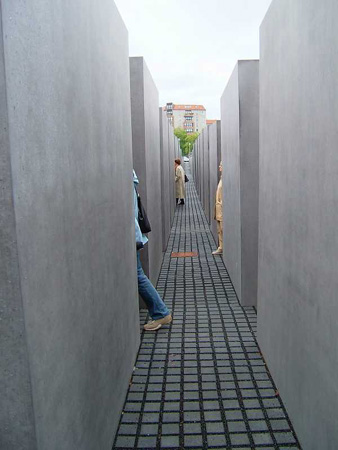ホロコースト記念碑HOLOCAUST MEMORIAL

2005年5月12日、先のドイツ連邦共和国の終戦60周年を記念して、「虐殺されたヨーロッパのユダヤ人のための記念碑」(通称ホロコースト記念碑)がオープンした。
この施設は、時遡る事1988年、ジャーナリスト、レア・ロッシュの呼びかけから始まり、On May 12th, 2005, commemorating the sixtieth anniversary of the end of the war in the Federal Republic of Germany, a Holocaust Memorial, in honor of the hundreds of thousands of European Jews that were persecuted and murdered was opened.様々な議論を経て漸く今年の開設の運びとなった。建設賛同人には、ヴィリー・ブラント、ギュンター・グラス、クリスタ・ヴォルフ等ドイツの各界著名人も名を連ねた。
![]()
設計は、ピーター・アイゼンマンによるもので、石碑の広場とその地下にある情報センターから構成される。
![]()
石碑の広場は2711基の石碑から構成される(2711基という数字は場所と規模から計算された数字であり、数字そのものに意味はないらしい)。すべての石碑は、縦2.38m横0.95mで、空洞のコンクリート製である。その間隔は規則正しく、おおよそ人ひとり、もしくは車いすが通行できる程度の幅であり、来場者は周辺の任意の場所から広場に入り、石碑の間を歩く事が出来る。石碑の広場の周辺付近では1m以下である石碑も、深部に足をすすめるにつれ、高さを増し、最大4mを越える。
![]()
石碑の広場の深部に足を踏み入れると、通路の出口にあたる空間と空しか見えないようになる。そして面白い事にどこからも陰になる場所がない。また石碑は規則正しく並んでいるようで、実際は微妙な傾きがあり、高さが違う。また、その床面は緩やかな勾配が不規則にあり、足下をややぐらつかせる。そしてそれぞれの隙間から様々な人がそこに現れては消え、また現れては消える。それが不連続に不定期に繰り返される。時として不意に手前の角から横切る人とぶつかりそうにもなる。造形はとてもミニマルで、シンプルであるが、そのような構造が様々な実社会でのドラマを喚起させる。
![]()
その一方で、地下の情報センターでは写真とテクスト、そして資料を中心にナチスの絶滅政策、その当時のユダヤ人の記録等を様々な角度から検証した展示を見る事ができる。検証はユダヤ人の歴史そのものにまで遡るため、迫害前後のコントラストから迫害のもたらした歴史的な意味合いを理解する事ができる。
![]()
ところで、多くの人が疑問に思うに違いない事が一つ挙げられる。この施設がユダヤ人にのみ捧げられていると言う事である。ホロコーストでは当然の事ながらユダヤ人以外にもシンティ、ロマ、そして同性愛者や政治犯も犠牲となっている。これらは別の形で記念碑を建てるよう既にドイツ連邦議会で議決済みである。ここでは、ヨーロッパのユダヤ人大量虐殺、という他に類を見ない犯罪を犯したドイツ国家の歴史的責任を認める事が重要視されている。その他の歴史認識に関してはまた別の形で実を結ぶ事となる予定である。
![]()
施設はベルリンの中心部に位置する。側には主たる観光スポットであるブランデブルグ門、ホテル・アドロン、ライヒスターク(国会議事堂)があり、各国大使館、各種文化施設、オフィス、住居、ティアーガルテン公園に隣接している。この事は、記念碑が社会に開かれている事を示している。ドイツ国民はもちろんの事、近い将来この施設も多くの観光客の訪れる重要な歴史的遺産となるに違いない。
![]()
ホロコースト記念碑
住所:Cora-Berliner-Strasse 1, 10117 Berlin
http://www.stiftung-denkmal.de
![]()
Text and Photos: Yoshito Maeoka The concept of the memorial started via an appeal of journalist Lea Rosh in 1988. Finally, after numerous discussions and discourse, it opened this year. Guenter Grass and Christa Wolf, well known throughout the world entered their name as supporters of the concept.
![]()
The Memorial, designed by Peter Eisenman, consists of open space for a multitude of stone monuments and an information center located underneath of the ground.
![]()
The open space is composed of 2711 stone monuments. It is said that the number was calculated according to the location’s size, and that the number itself does not have any specific meanings. All stones are 0.95 meters by 2.38 meters and made of concrete with a hollow inside. Spaces between each stones are constant, just about the size of a person or a wheelchair can pass through without difficulty. Visitors are able to get in the area from many different points and walk through the space between the stone monuments. The height of the stones located near the open space are below one meter. As one keeps walking further, they gradually increase in height and the tallest ones exceed four meters.
![]()
Eventually, only the exit and the sky can be seen as one walks towards the center of the area. The interesting thing is that there are no spots to create shadows. The stones look as if they are standing in a perfect line, in constant order, but actually they lean slightly and have varying heights. The ground is gently sloped. People show up in between the gaps in the stones and then vanish. Sometimes, you may bump up against somebody who is crossing the same time as you. The modeling is very simple and minimal. A structure like this reminds people of tracing history in various ways.
![]()
The information center underneath the ground displays photographs, texts, and data. It looks at the Nazi extermination policies and records of the Jewish people. The exhibit portrays the history of the Jews as well. By tracing the time before and after their persecution, it shows some of the views of history brought about by the affair.
![]()
Now, there is one question here. Is the Memorial dedicated only for Jews? During the Holocaust period the Jews were not the only victims. The Sinti and Roma, homosexuals and political criminals were also killed. Actually, the German federal council has already decided to construct memorials for them in different ways. The important fact here is to recognize the historical responsibility of the Germany that committed the crime of nearly wiping out the entire European Jewish population. Understanding other aspects of history will be accomplished in different ways.
![]()
The Memorial is located in the center of Berlin. In the neighborhood, there are many tourism spots, such as the Brandenburg Gate, Hotel Adlon and the Reichstag Parliament Building. It also neighbors embassies of many countries, cultural facilities, offices, residences, and the Park of Tiergarten. This shows that the Memorial is open for the society. Not only Germans but also many tourists will visit here in the near future, and it will be one of the most important historical heritages in the world.
![]()
Holocaust Memorial
Address: Cora-Berliner-Strasse 1, 10117 Berlin
http://www.stiftung-denkmal.de
![]()
Text and Photos: Yoshito Maeoka
Translation: Kosai Kato大屠杀纪念馆
地址:Cora-Berliner-Strasse 1, 10117 Berlin
http://www.stiftung-denkmal.de
